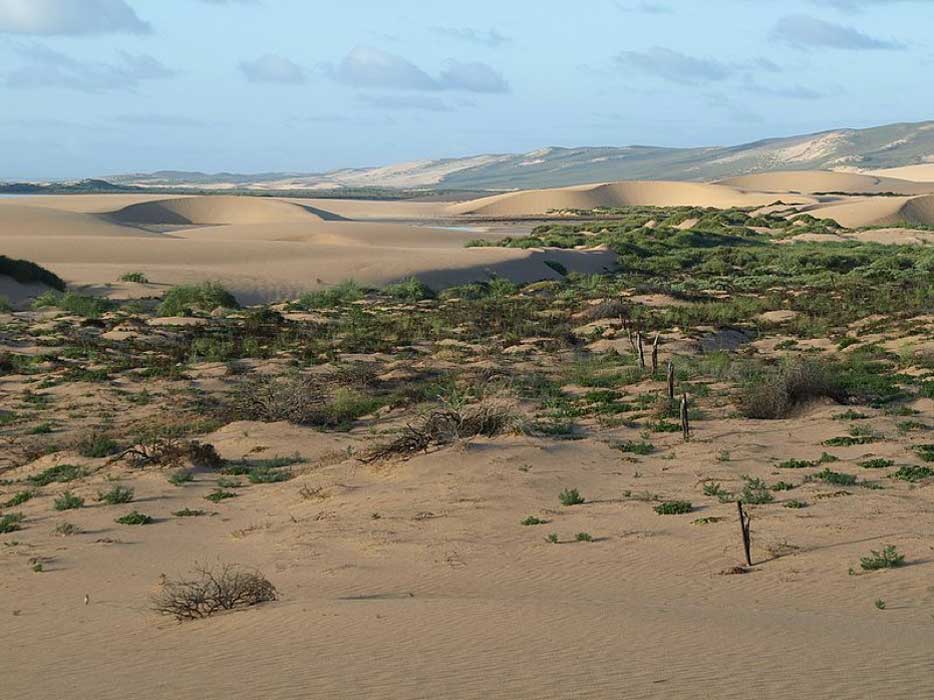Australian Dirk Hartog Island Undergoes $16million Fauna Roll Back to 1616
One of Australia's oldest landing sites of pre-European settlement has been successfully restored to “how it was 400 years ago” saving an entire ancient ecosystem from collapse.
Dirk Hartog Island off Western Australia's northern coast was one of the first parts of Australia discovered by European explorers in AD 1616. Now, the island has become one of the world's largest and most successful ecological restoration projects that has returned the isle “to what it was before Dutch explorers first landed there” according to a report on ABC.NET.AU.

A colorful panorama of Dirk Hartog Island, Western Australia. (CC BY NC 2.0)
Margaret Byrne, director of science and conservation at the Department of Biodiversity Conservation and Attractions told reporters "The long-term goal for this project is to recreate the ecosystem that was once there on the island prior to the land practices that we introduced once it was settled.” Dirk Hartog Island Ecological Restoration Project manager John Asher told reporters that the project has been ongoing “for 20 years and has only this month enabled the island to be declared free of feral cats, goats and sheep.” The project has reintroduced native animals in the hope of providing threatened species with what Asher called a “sanctuary to thrive.”
"When Dirk Hartog arrived on Dirk Hartog Island back in 1616, there was 13 species of ground-dwelling animals on the island, and since 150 years of pastoralism and feral introduction of cats on the island there's only three left” said Asher.A primary goal of the project, Asher added, was “to get all of these 10 animals back on the island and, if we can recover them, we can then use them as stock to spread elsewhere in Australia as well.”

Map location of Dirk Hartog Island, (CC BY SA 2.0)
Claimed with a plate on a post
Hartog was on his way to Java onboard the Dutch East India Company ship Eendracht when he became the first European to discover the island on 25 th October 1616, 154 years before Captain James Cook arrived to claim the eastern part of Australia for Britain. Before leaving “he nailed a plate, inscribed with his name and the names of other senior crew members, to a post on the island” which was later collected by another Dutch explorer and taken to the Netherlands. Hartog’s discovery plate is “the oldest surviving European artifact relating to Australia” according to Asher.
- Have Experts Finally Located the Wreck of Cook’s Ship HMS Endeavour?
- Did Portuguese beat Captain Cook to Australia by 250 years?
- Ancient African Coins Found in Australia Pose Interesting Questions About the Nation’s History

Original Dirk Hartog's plate in the Rijksmuseum, Amsterdam. (Public Domain)
100 years later, in AD 1772, French explorers stumbled across the island, which is 80 kilometers long and 15km across at its widest point, and in 1869 Francis Louis von Bibra leased the island and “established a flock of sheep.” The island remained a pastoral lease for 150 years until 2009 when it became a national park focused on returning the island to its 'pre-white settlement’ glory.
The ambitious project, called ‘Return to 1616’, began with three years of the ‘removal’ of thousands of “feral cats, sheep and goats” from the island. "The key thing we needed to do was remove feral cats. Feral cats are a major predator of small mammals,” said Ms Byrne. She also said that eradicating cats from the island "has been a difficult task. The island is 63,000 hectares so it's the largest island in the world feral cats have been removed from.”
- New Research May Establish Australian Rock Art as the Oldest in the World
- Written in Stone: Neolithic Weapons and Tools of the Australian Aboriginals
- 80 Percent of This Town in Australia Lives Underground!
Environmentalists Battled with Feral Cats
According to Ms Byrne, the battle against feral cats was approached strategically with the erection of a fence to create “two cells, so we had a northern part of the island and a southern part of the island. The island was then baited enabling “the monitoring in the southern area first and then the northern area.”
"That came from our science experts being able to understand what the complexities of the field operations would be and bringing that expertise to bear and understand what was the right way to design the program so we were going to achieve outcomes with the minimum amount of resources,” said Ms Byrne.
140 rufous and banded hare-wallabies from nearby Bernier and Dorre Islands were the first new inhabitants to be relocated to the island. Stephen Dawson, Environment Minister for Western Australia said “the project was part of a broader suite of measures the State Government was undertaking to create animal sanctuaries for threatened species.” Dawson also reflected over the past 200 years:
“we've seen our species threatened because of land clearing, because of urbanization, so to have arks like this available in the state where we can restore the animals is very important […] that have been under threat since white colonization of Australia.”
Top image: Tetrodon Loop, Dirk Hartog Island, Shark Bay, Western Australia Source: CC BY-SA 4.0
By Ashley Cowie



















